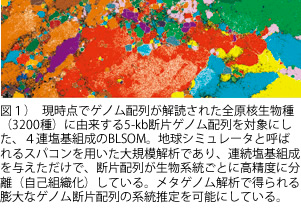客員教授
 池村 淑道(いけむら・としみち)
池村 淑道(いけむら・としみち)
Toshimichi Ikemura
専門分野/ゲノム科学、ゲノム進化学、バイオインフォマティクス
職位:客員教授、名誉教授
学位:理学博士(京都大学)
- 京都大学理学研究科物理学専攻博士課程修了
- 国立遺伝学研究所、総合研究大学院大学教授を経て同研究所・同大学院大学名誉教授
- 長浜バイオ大学コンピュータバイオサイエンス学科教授、学部長・研究科長を経て現職
- 日本遺伝学会賞・日本進化学会賞を受賞
研究テーマ

(1)「ビッグデータからの知識発見」
ゲノム配列の連続塩基(オリゴヌクレオチド)組成には、各生物のサインと呼べるような明瞭な特徴が存在するが、kbレベルに断片化してもその特徴を検出できるBLSOMと呼ぶ新手法を確立した。G+C%としてゲノムを特徴付けていた一変数を、多変数(4連塩基組成では256の変数)へ拡張した解析である。現時点でゲノムが解読された全生物種の配列を一枚のマップ上に表示し(図1)、ゲノム配列の生物系統別での特徴の検出を可能にする。このマップ用いれば、多数の未知生物のゲノム断片を解読するメタゲノム解析で得られた膨大な配列の系統推定が可能となる(論文3)。進化速度の速いインフルエンザウイルスのゲノム配列にBLSOMを適用すると、限定された範囲ではあるが、ゲノム配列の変化方向を予測可能なことも明らかにした(論文2,4)。ヒトゲノム配列の5連塩基組成を解析することで、セントロメア近傍のヘテロクロマチン領域に転写因子の結合配列が顕著に集中して存在することも見出した(論文1)。
(2) 「エボラ出血熱、インフルエンザ、HIV用の核酸医薬のデザイン」
エボラ出血熱のように人類に多大な危機をもたらす可能性のある疾患に対しては、様々な先端技術を持ち寄って早急な対策を立てることが重要になる。エボラやインフルエンザウイルスやHIVの増殖を抑える医薬品の候補の一つとして核酸医薬が考えられているが、核酸医薬の英語名がtherapeutic oligonucleotideであることからも明らかなように、オリゴヌクレオチド(具体的には、20 ~ 30連続塩基の核酸断片)を「アンチセンスRNA やsiRNA」のような遺伝子発現のブレーキ役として用いる方法である。我々のチームは、多様なゲノムのオリゴヌクレオチド組成をBLSOMで研究してきた成果を基礎に、病原ウイルスの遺伝子発現を抑えるが、ヒト遺伝子の発現には影響を与えない核酸医薬を、高機能計算機を用いてデザインしている。膨大なヒトゲノムやヒトRNA、並びに大量なウイルス株のゲノムについて、20連続塩基(420:約1兆個の変数)の頻度解析が必要になり、超高次元のビッグデータ解析となり、世界的にも高水準のコンピュータを用いる研究開発となる。これからのコンピュータバイオサイエンス学科の教育と研究に正に相応しい課題である。
| 研究の応用領域 | 産官学連携で求めるパートナー |
|---|---|
| オリゴヌクレオチド核酸医薬のデザイン。環境からの有用遺伝子資源の情報学的探索。健康・長寿に係わるゲノム情報の解析。高機能計算機を用いたゲノム情報解析。インフルエンザを含むウイルスのゲノム情報解析。 | メタゲノム解析を用いた環境からの有用遺伝子探索に興味のある企業と研究機関。健康長寿に係わるゲノム情報の解析に興味のある企業と研究機関。ビッグデータに興味のある企業と研究機関。核酸医薬に興味のある企業と研究機関。 |
Topics of research
Our group has developed a bioinformatics tool "BLSOM (Batch-Learning Self-Organizing-Map)", which can analyze more than one million genomic sequences simultaneously, and therefore, allow us to gain efficiently a wide range of knowledge from the big sequence data.
- Efficient knowledge discovery from big sequence data
BLSOM with oligonucleotide (e.g. tetranucleotide) composition, which can cluster genomic sequence fragments (e.g. 1-kb sequences) according to phylotype by using only the oligonucleotide composition (Fig. 1), has been successfully applied to the phylogenetic classification of a large number of metagenomic sequences [3]. Oligonucleotides such as tetra - heptanucleotides often represent motif sequences responsible for sequence-specific protein binding (e.g. transcription factor binding). Occurrences of such motif oligonucleotides should differ from the occurrences expected from the mononucleotide composition in the respective genome and may differ among genomic portions within a single genome. Actually, we have recently found that a pentanucleotide-BLSOM for the human genome can detect characteristic enrichment of many transcription-factor-binding motifs in pericentric heterochromatin regions [1].
Influenza virus is one of zoonotic viruses and shows clear host tropism. Important issues for bioinformatics studies of influenza viruses are prediction of genomic sequence changes in the near future and surveillance of potentially hazardous strains. To characterize sequence changes in influenza virus genomes after invasion into humans from other animal hosts, we applied BLSOMs to analyses of oligonucleotide compositions in all genome sequences of influenza A and B viruses and found clear host-dependent clustering (self-organization) of the sequences [2,4]. Retrospective time-dependent directional changes of oligonucleotide compositions, which were visualized for human strains on BLSOMs, could provide predictive information about sequence changes in newly invaded viruses from other animal hosts (e.g. the swine-derived pandemic H1N1/09). The strong visualization power of BLSOM also provides surveillance strategies for efficiently detecting potential precursors to pandemic viruses. - Big data bioinformatics for designing therapeutic oligonucleotides for ebolavirus, HIV, and inf luenza virus diseases
RNA viruses, such as ebolavirus, HIV, and inf luenza viruses, present signif icant threats to public health, as highlighted by recent ebolavirus-outbreaks in West Africa. To overcome such threats, it is important to conduct interdisciplinary studies by introducing various new technologies including informatics suitable for big data analyses. We have recently applied the "oligonucleotide-BLSOM" for designing therapeutic oligonucleotides for ebolavirus, HIV, and influenza virus diseases. Since the BLSOM is a powerful strategy to unveil characteristics of oligonucleotide composition of each genome and its fragments (i.e. genome signature), we can design candidates for the therapeutic oligonucleotide usable for antisense RNAs and siRNAs for these viruses that should have the least of f -target side ef f ect.
主な業績論文等
- Wada K., Wada Y., Iwasaki Y. and Ikemura T. Time-series oligonucleotide count to assign antiviral siRNAs with long utility fit in the big data era. Gene Therapy. 24, 668-673 (2017).
- Iwasaki Y., Wada K., Wada Y., Abe T. and Ikemura T. Notable clustering of transcription-factor-binding motifs in human pericentric regions and its biological significance. Chromosome Res. 5, 461-474 (2013).
- Iwasaki Y., Abe T., Wada K., Wada Y. and Ikemura T., Nobel bioinformatics strategies for prediction of directional sequence changes in influenza virus genomes and for surveillance of potentially hazardous strains, BMC Infec Dis. 21, 386 (2013)
- Nakao R., Abe T., Nijhof A. M., Yamamoto S., Jongejan F., Ikemura T. and Sugimoto C., A novel approach, based on BLSOMs (Batch Learning Self-Organizing Maps), to the microbiome analysis of ticks. ISME J. 7, 1003-1015 (2013).
- Iwasaki Y., Abe T., Wada K., Itoh M. and Ikemura T., Prediction of directional changes of influenza A virus genome sequences with emphasis on pandemic H1N1/09 as a model case. DNA Res., 18, 125-136 (2011).
- Abe T., Ikemura T., Sugahara J., Kanai A., Ohara Y., Uehara H., Kinouchi M., Kanaya S., Yamada Y., Muto A. and Inokuchi H., tRNADB-CE 2011: tRNA gene database curated manually by experts. Nucleic Acids Res. 39, D210-D213 (2011).






